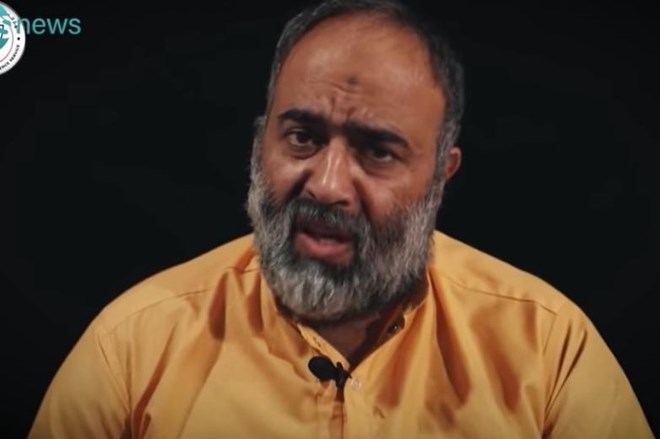
Monday December 3, 2018

The Iraqi authorities released a video on Friday with the confession of a recently captured Islamic State operative who was involved in a notorious incident in which captured Kurdish soldiers were put in cages and paraded around a northern Iraqi city by hooded Islamic State fighters.
newsideAt the time, early 2015, the Islamic State was threatening to burn them to death much as they had done two months earlier to a Jordanian pilot who had been captured, caged and then set on fire in Syria. It is not clear how the Kurdish captives were killed.
The captured operative, Jamal al-Mashadani, who was known by the nom de guerre Abu Hamza al-Kurdi, was an officer in President Saddam Hussein’s security apparatus before joining Al Qaeda in Iraq after Mr. Hussein’s fall. Mr. Mashadani later shifted his loyalty to the Islamic State.
He is one of a relatively small number of midlevel and higher level officials to have been captured by the Iraqis, the Americans or through the combined efforts of American and Iraqi intelligence services. Five other Islamic State officials were captured in May. The Iraqis have also captured several thousand lower-level fighters. Many other Islamic State officials and fighters were killed in battle.
In a 17-minute confession video released by Iraqi intelligence on Friday, Mr. Mashadani, who appears to be solidly built and balding with a salt-and-pepper beard, says that he was born in 1973 and is from Tarmiya, a town north of Baghdad, and that he graduated from Iraq’s College of National Security in 1992 before joining the country’s military intelligence.
There was no way to tell if the confession had been coerced or obtained through torture. Iraq has a record of disregarding due process protections and using confessions as evidence of guilt.
Mr. Mashadani, unlike many of the foreign fighters who came to Iraq and Syria from elsewhere to support the Islamic State, had technical and organizational skills that the group needed to expand its reach.
“He’s one of the real professionals and brains who built ISIS, the faces not usually recognized in discussions about the group,” said Hassan Hassan, the author of a book tracing the rise of the Islamic State, also known as ISIS.
He added that Mr. Mashadani was “one of the little-known but critical leaders within ISIS who served under Saddam Hussein’s regime.”
While not a senior leader, Mr. Mashadani held important midlevel managerial positions within the Islamic State. More important, he is among the trained cadre of military and intelligence professionals that the group, much like Al Qaeda before it, was able to recruit from the ranks of Mr. Hussein’s dissolved police state.
Mr. Hassan says that Mr. Mashadani was involved in the terrorist group’s chemical weapons program. He also served as the Islamic State’s governor in Kirkuk and in northern Baghdad, two administrative areas that had belonged to the Islamic State’s Britain-sized caliphate.
American officials familiar with Mr. Mashadani confirmed his role in the organization and that he was captured.
He had previously been captured by the Americans in 2006 and imprisoned at Camp Cropper, one of the two major detention centers run by the United States. He was released in mid-2011, he said in the video, and joined the Islamic State two years later.
His detention in an American facility was considerably longer than that of the Islamic State’s leader, Abu Bakr al-Baghdadi, who spent a little less than a year in an American prison in Bucca, Iraq.
In the video, Mr. Mashadani detailed his involvement in the Islamic State, including his meetings in 2014 with Mr. Baghdadi, whom he said gathered the governors of different Iraqi provinces in Mosul to give them instructions on running their areas and to have joint discussions on issues such as what to do with the “spoils” that the Islamic State commanders took from people in areas they captured.
Later, Mr. Mashadani moved to Kirkuk as the Islamic State governor, he said, and there he supervised or was involved in several higher profile operations. They included the bombing of the small northern town of Taza with rockets, some of which were loaded with chemical agents — sulfur mustard and chlorine — that seeped out although few if any exploded, according to news reports at the time.
He then was involved in the operation that captured the Kurdish pesh merga soldiers, although he says that 18 were captured, not 21, the number given in news reports and by Iraqi intelligence. The pesh merga were dressed in orange jumpsuits and paraded around the city of Hawija in cages “to lift morale” of Islamic State supporters, Mr. Mashadani said.
Later that year, Mr. Mashadani participated in Islamic State operations near the ancient Roman ruins of Palmyra, Syria, which was taken by the Islamic State in 2015 and held for about a year. By then, the Islamic State’s power and geographic reach had shrunk drastically, but he still appears to have been entrenched: He held several administrative positions, some involving considerable responsibility.
In 2017, he decided to leave Syria and the Islamic State, he said.
He cited as reasons for his departure the bombing by coalition forces, the targeting of commanders like himself and the “poor management” by some of Mr. Baghdadi’s lieutenants.
He was captured at his son’s house in Baghdad, he said. Iraqi intelligence confirmed that he was captured in Baghdad.
That he was captured relatively close to his family home in Tarmiya suggests that some Islamic State fighters who have not been killed may be trying to return to their homes and meld into the local population.